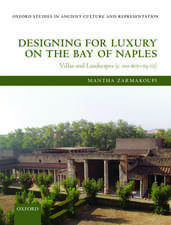Ashes, Images, and Memories: The Presences of the War Dead in Fifth-Century Athens
Autor Nathan T. Arringtonen Limba Engleză Paperback – 10 ian 2019
| Toate formatele și edițiile | Preț | Express |
|---|---|---|
| Paperback (1) | 285.09 lei 31-37 zile | |
| Oxford University Press – 10 ian 2019 | 285.09 lei 31-37 zile | |
| Hardback (1) | 603.40 lei 31-37 zile | |
| Oxford University Press – 15 ian 2015 | 603.40 lei 31-37 zile |
Preț: 285.09 lei
Preț vechi: 325.57 lei
-12% Nou
Puncte Express: 428
Preț estimativ în valută:
54.55€ • 57.10$ • 45.40£
54.55€ • 57.10$ • 45.40£
Carte tipărită la comandă
Livrare economică 20-26 martie
Preluare comenzi: 021 569.72.76
Specificații
ISBN-13: 9780190936693
ISBN-10: 019093669X
Pagini: 360
Ilustrații: 85 illus.
Dimensiuni: 231 x 163 x 15 mm
Greutate: 0.64 kg
Editura: Oxford University Press
Colecția OUP USA
Locul publicării:New York, United States
ISBN-10: 019093669X
Pagini: 360
Ilustrații: 85 illus.
Dimensiuni: 231 x 163 x 15 mm
Greutate: 0.64 kg
Editura: Oxford University Press
Colecția OUP USA
Locul publicării:New York, United States
Recenzii
Nathan Arrington's erudite and thoughtful book conjoins a mastery of social history, art history, and field archaeology to explain the role of commemorating war dead in Athenian cultural expression and political development. He offers new and convincing interpretations of the chronology and topography of public rituals honoring the fallen. This has big implications for rethinking the iconography and reception of major monuments and the relationship between war, memory, and democracy. While always sensitive to ancient cultural specificity, Arrington draws telling, and often haunting, parallels between the attempts of democracies ancient and modern to represent to themselves the sacrifice and irreplaceable loss of young men who die fulfilling the purposes of their country. This is a major contribution to the literature on war, art, memory, and ritual. It deserves a wide readership within and beyond ancient studies."
As the centenary of the First World War turns people's attention to the revolution in the culture of commemoration of the war dead effected by that conflict, it is highly appropriate that Nathan Arrington should bring to our attention, as never before, the culture of commemorating the war dead developed in fifth-century Athens. Arrington shows how, by giving the war dead a special status marked by word, deed, and monument, the community from which the dead soldiers had come came to see itself differently. This is not only a challenging example of how to make objects and texts, images and actions, speak to each other, but an eloquent testimony to the extraordinarily pervasive power that the dead can come to exercise over all aspects of a community's life."
'Age shall not weary them, nor the years condemn'. Original, meditative, subtle, beautifully crafted, wide-ranging, and brilliantly synthesizing archaeology, art, and text, Arrington's study offers a magisterial new perspective on an enduring human problem. There is nothing as good or as thoughtful on managing the human cost of war as this."
...Arrington demonstrates that theoretical debate in classical archaeology can productively coexist with the discipline's empiricist traditions. His analyses are coherent and incisive, from the level of individual objects and sites to the broader debates concerning methodological direction. Readers from different fields and levels of specialization will be amply rewarded.
This fine and ambitious book is made more valuable by its footnotes and bibliography, a treasure trove for students and scholars alike both to check [Arrington]'s sources and to explore more deeply the many media and questions he tackles. [Arrington]'s elegant prose is a pleasure to read and his thought-provoking examination lingers in the mind long after the book has been finished.
As the centenary of the First World War turns people's attention to the revolution in the culture of commemoration of the war dead effected by that conflict, it is highly appropriate that Nathan Arrington should bring to our attention, as never before, the culture of commemorating the war dead developed in fifth-century Athens. Arrington shows how, by giving the war dead a special status marked by word, deed, and monument, the community from which the dead soldiers had come came to see itself differently. This is not only a challenging example of how to make objects and texts, images and actions, speak to each other, but an eloquent testimony to the extraordinarily pervasive power that the dead can come to exercise over all aspects of a community's life."
'Age shall not weary them, nor the years condemn'. Original, meditative, subtle, beautifully crafted, wide-ranging, and brilliantly synthesizing archaeology, art, and text, Arrington's study offers a magisterial new perspective on an enduring human problem. There is nothing as good or as thoughtful on managing the human cost of war as this."
...Arrington demonstrates that theoretical debate in classical archaeology can productively coexist with the discipline's empiricist traditions. His analyses are coherent and incisive, from the level of individual objects and sites to the broader debates concerning methodological direction. Readers from different fields and levels of specialization will be amply rewarded.
This fine and ambitious book is made more valuable by its footnotes and bibliography, a treasure trove for students and scholars alike both to check [Arrington]'s sources and to explore more deeply the many media and questions he tackles. [Arrington]'s elegant prose is a pleasure to read and his thought-provoking examination lingers in the mind long after the book has been finished.
Notă biografică
Nathan T. Arrington is an Associate Professor of Classical Archaeology at Princeton University.


















